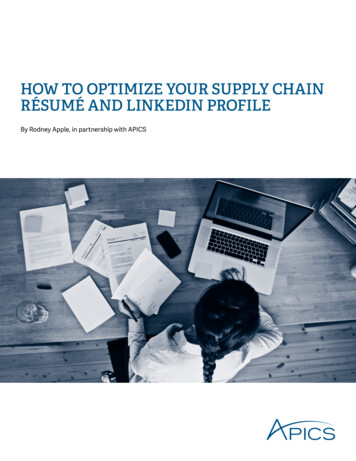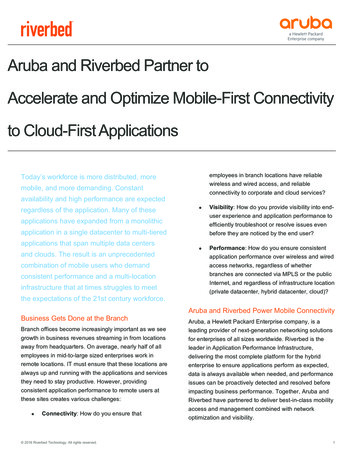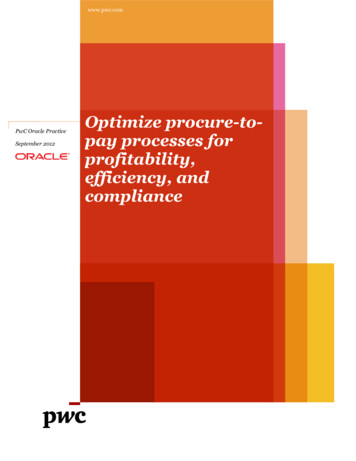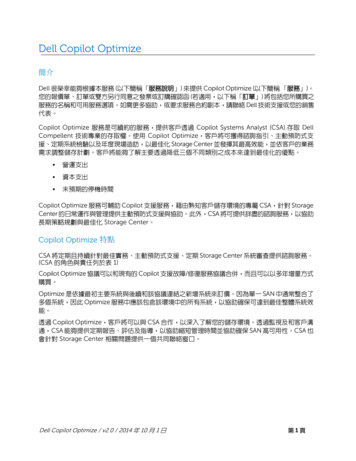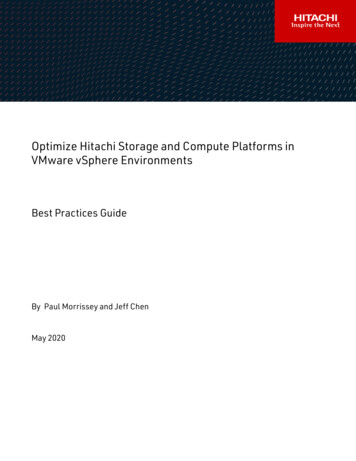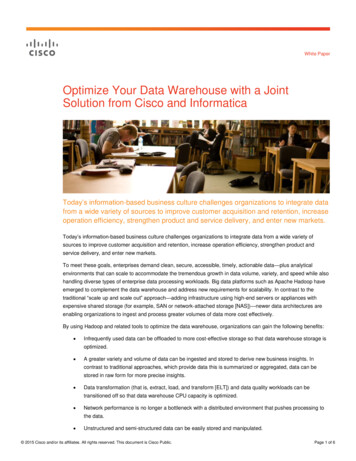
Transcription
Treasury and Trade SolutionsHow to Optimize the Benefitsof In-House BankingBasak ToprakEMEA Sales, Treasuryand Trade Solutions,CitiIn-house banking plays a crucial role in helping corporatesto achieve operational efficiency, financial optimization andeffective risk management. Tools such as Virtual Accountscan deliver these benefits quicker and easier than ever, writeBasak Toprak, EMEA Sales, and Carolina Prieto, Core CashGlobal Market Manager, Citi Treasury and Trade Solutions.Companies around the world face increasing headwinds to growth, heightened volatility andgrowing uncertainty over a potential trade war between some of the world’s most importanteconomies. In response, many corporates are seeking to improve efficiency by centralizing coretreasury functions and aggregating subsidiary transaction flows and risks. An In-House Bank (IHB)is a key construct in achieving such benefits.Carolina PrietoCore Cash GlobalMarket Manager,Treasury and TradeSolutions, CitiIHBs are structured as a separate legal entity and are usually managed by a multinational group’sregional or global treasury. They operate across a range of functions, such as cash concentration,foreign exchange and funding. IHBs manage their own profitability and financial position and act ina similar way to a bank for group entities — subsidiaries transact with the IHB at arm’s-length andthe IHB and group subsidiaries maintain intercompany loans and accounts.By sitting between the group’s various financial service providers, financial markets and groupentities, IHBs can concentrate treasury activities, reducing the volume of external FX andcash transactions and the number of bank accounts and relationships, helping to lower costs.Aggregation of transactions also reduces reconciliation volumes, improving operational efficiency,and can optimize negotiation positions with financial service providers.
2Treasury and Trade SolutionsMany companies have surplus liquidity in one location but need to borrow inanother; an IHB makes it easier to optimize liquidity group wide, lowering overallborrowing levels and maximizing returns from investing surplus cash. As wellas generating efficiency and financial benefits, IHBs provide an opportunity toadopt standardized and automated financial processes and tighter controls,improving visibility, control and risk management across liquidity, FX, interest andcounterparty risk.A step-by-step approachPutting an IHB in place takes time. The results of Citi Treasury Diagnostics, abenchmarking survey based on inputs from over 800 large corporates, showscorporations tend to build out their IHBs in stages. These stages typically include:1. Establishing a finance company focused on segregated liquidity management(with no co-mingling) and intercompany netting;2. Centralizing liquidity management across entities and currencies, externalinvestments, and cash forecasting and risk management;3. Integrating with legal entities for intercompany netting and on-behalf-of (OBO)structures, such as payments-on-behalf-of (POBO) and receivables-on-behalf-of(ROBO). OBO structures allow corporations to leverage their infrastructure toachieve an even greater level of centralization by concentrating operating flowsat treasury level. An in-house bank manages payments and collections from amaster account on behalf of subsidiaries in a region or globally.Stage 1Financecompany:focused onintercompanynettingStage 2Centralizingliquidity,investmentand riskmanagementStage 3Integrated withlegal entitieshaving onbehalf-of (OBO)structures
How to Optimize the Benefits of In-House Banking3Accelerating the benefits of IHBsThe stages described above remain logical steps for companies to realize the operational efficiency, financial optimization andrisk management benefits of an IHB. However, sophisticated banking and integration tools, such as Virtual Accounts, are makingit easier and faster for corporations to simplify, streamline and consolidate their treasury and operational flows.Virtual Accounts resemble traditional bank accounts, with a specific number designating a specific account. However, rather thanbeing individual physical accounts, these numbers are instead simply used to segregate flows relating to a single physical account.This physical account is in the name of the IHB; Virtual Accounts are established in the name of various operating legal entities.Virtual Accounts are valuable in IHB stages 2 (treasury functionality) and 3 (integrated with legal entities) as outlined in thegraphic below.Application of Virtual Accounts in IHB StagesImplementing Virtual Accounts during these core IHB stages will helpyour company to simplify, streamline and consolidate your treasuryand operational flows.StageFunctionsFinance panyNetting—CashSettlementIHB (Treasury izeExternalInvestments(No Co-mingling)CentralizeCashForecastand RiskManagementIHB (Integrated with Legal reased centralization and range of services*General Purpose of LiquidityCentralization Stage:General Purpose of“On Behalf Of” Stage(s): Cash pooling to IHB Subsidiary funding Netting of outstanding balances Migrate payments/receivables flowsto IHB Minimize need for local funding Centralize currency positions Additional account reduction Simplify liquidity management* While IHB functions are set out here sequentially, these stages can be re-ordered based on your company’s own strategic objectives of IHB set up. The above depicts avisual of a more common IHB progression based on Citi Treasury Diagnostics results.
4Treasury and Trade SolutionsImplementationof VirtualAccounts reducesthe number ofphysical accountsneeded andthe numberof physicalsweeps betweenaccounts.Stage 2: Liquidity centralizationVirtual Accounts can help with liquidity centralization by minimizing the numberof sweeps needed to centralize liquidity in a cash pooling structure. Companiesoften have multiple bank accounts for the same legal entity in order to differentiatebetween Accounts Payable or Accounts Receivable flows, or indeed flows related todifferent projects or business lines. Virtual Accounts can be leveraged to segregatethese flows under the same legal entity without the need to open separate physicalbank accounts. Even if multiple physical accounts are already open, Virtual Accountscan support with bank account rationalization and the minimization of sweeps.Stage 3: The role of Virtual Accounts inOBO transactionsVirtual Accounts also facilitate process and create benefits within the third IHBstage, where an IHB is integrated with legal entities using an OBO structure— payments are made from, or received into, Virtual Accounts and cantherefore be easily differentiated. By supporting the migration of paymentsand receivables flows to an IHB, Virtual Accounts minimize the need for localfunding to support payments, centralize currency positions into IHB, allow for areduction in the number of accounts held, and simplify liquidity management.When POBO payments are made from a Virtual Account, they go to the beneficiaryin the name of the underlying entity and therefore provide the beneficiary with fullpayer details. Similarly, when payments are received into a Virtual Account (ROBO),the IHB has absolute clarity of the entity these payments are destined for.Implementation of Virtual Accounts reduces the number of physical accountsneeded and the number of physical sweeps between accounts. Virtual Accountsalso instantly reflect changes in balances of IHB accounts, which results in improvedliquidity efficiency for the corporation.The use of an IHB structure and OBO payments without bank-provided VirtualAccount structures potentially limits the amount of information available, whichmakes reconciliation difficult both for payments (for beneficiaries) and receivables(for the IHB).Without the use of a bank’s Virtual Accounts, ROBO payments go directly into theIHB account and may not have the details that make it clear where payments aredirected. Similarly, although POBO is supported by internal IHB accounts withinan Enterprise Resource Planning (ERP) platform, the specific payment beneficiarydetails are usually entered in the Transaction Reference Details, which may notalways be forwarded to the beneficiary. Consequently, reconciliation can be timeconsuming and complex for the beneficiary.
How to Optimize the Benefits of In-House Banking5Integrating Virtual Accounts into ERP and TMS platformsAccounting principles have historically allowed for accounts to have sub-accounts, traditionally to manage internal accountingstructures for inventory, payables or receivables. This principle is leveraged to aid reconciliation by having Virtual Accountslinked to the physical account structure of the IHB through ERP and Treasury Management Systems (TMS), many of which nowsupport Virtual Accounts. The account structure hierarchy is essentially the same across the bank platform and the ERP or TMS,making one-to-one reconciliation straightforward.By linking Virtual Accounts with the physical account structure of the IHB through ERP and TMS, it is possible to automatereconciliation of receipts and payments, in turn improving days sales outstanding and increasing the working capital of acompany. It is critical to ensure the configuration of Virtual Accounts in the ERP or TMS platforms match the set up at thefinancial service provider. Any mismatch may jeopardize automated reconciliation.It is critical to ensure theconfiguration of Virtual Accountsin the ERP or TMS platforms matchthe set up at the financial serviceprovider. Any mismatch mayjeopardize automated reconciliation.
6Treasury and Trade SolutionsChoosing the right partnerVirtual Accounts and supporting services have the potentialto transform how companies manage payables andreceivables through IHB solutions. Benefits include reducedcosts and improved working capital as a result of accountrationalization, easier reconciliation and instant access toliquidity. Visibility, information sharing and reporting are alsoenhanced as all debits and credits from multiple subsidiariesare visible in a single entity (the IHB). As ERP and TMSproviders continue to partner with financial service providersto develop and expand these solutions, companies will be ableto achieve further benefits.Corporates seeking to gain the advantages of VirtualAccounts for POBO and ROBO through an IHB structure needto ensure they work with the right banking partner. Whilea number of global and regional banks now have VirtualAccount capabilities, their functionality and potential forintegration into ERP and TMS, which is essential to optimizevisibility, control and efficiency, differs widely between banks.Citi Virtual Accounts leverages the strength of Citi’s onthe-ground presence while delivering a globally consistentoffering; the solution is live with clients in Western Europecovering 37 currencies, with the U.S. and Asia to follow.The flexibility offered by Citi’s solution allows clients toindividually view transaction activity, manage online bankingentitlements and generate Virtual Account statements.Virtual Account structures can be configured for a singleentity or to support the OBO model of an IHB. Clients canharness additional transparency for accounts receivables byusing Citi Virtual Accounts in conjunction with Citi Payer IDAccounts to further automate the reconciliation process. Inaddition to servicing treasury needs, the capabilities can alsobe used as a business enabler for emerging client segmentsincluding digital marketplaces and the sharing economy tosegregate payment flows.Virtual Accounts have multiple use cases, including liquidityoptimization, segregation of flows and OBO payments; theysupport automation, reduce costs and enable companies toleverage a scalable framework across their ERP and bankinginfrastructure. Virtual Accounts address multiple pain pointsand support the creation of more efficient treasuries.Virtual Accounts InfographicEnterprise Resource Planning (ERP)Treasury Management System (TMS)In-House Bank(IHB) entityxxx-xxx-1234BankProvider*xxx-xxx-1234Paying and ReceivingOn-Behalf-Of EntitiesPhysical AccountIHB entityFunds physically moveout of IHB AccountSubsidiary Axxx-xxx-4567xxx-xxx-4567Virtual AccountSubsidiary ASupplierFunds notionally move out of subsidiary’s Virtual AccountFunds physically moveinto IHB AccountSubsidiary Bxxx-xxx-7890xxx-xxx-7890Virtual AccountSubsidiary BFunds notionally move into subsidiary’s Virtual Account* Credits and Debits take place at IHB Physical Account, flows are segregated by Virtual AccountsCustomers
Treasury and Trade Solutionsciti.com/treasuryandtradesolutions 2018 Citibank, N.A. All rights reserved. Citi and Arc Design is a registered service mark of Citigroup Inc.176259312/18
leverage a scalable framework across their ERP and banking infrastructure. Virtual Accounts address multiple pain points and support the creation of more efficient treasuries. Virtual Accounts Infographic *Credits a
